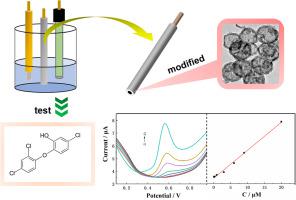Journal of Environmental Chemical Engineering ( IF 7.4 ) Pub Date : 2021-07-08 , DOI: 10.1016/j.jece.2021.106022
Xinwen Huang 1 , Anhua Jiang 1 , Xiaoqiang Jin 1 , Hangdi Yu 2 , Yirong Zhang 1 , Shasha Xia 1 , Zongjian Liu 2 , Geshan Zhang 2 , Dionysios D. Dionysiou 3

|
Nitrogen-doped hollow carbon (N-HC) nanospheres were fabricated by in-situ pyrrole polymerization on the hard template of ferroferric oxide nanospheres followed by acid treatment and calcination. The morphology, microstructure, surface composition and electroactivity for triclosan detection of as-prepared N-HC nanospheres were investigated. These N-HC nanospheres own single or double shells (shell thickness ≈ 20 nm, average diameter ≈ 250 nm). X-ray photoelectron spectroscopy measurement shows that the doped nitrogen in N-HC nanospheres is mainly graphitic and pyridinic nitrogen. N-HC nanospheres modified glassy carbon electrode (GCE) exhibits excellent electrochemical activity for electrooxidation of triclosan, resulting in the high efficiency for triclosan detection. The detection limit of triclosan is 30 nM and the limit of quantification is 100 nM, while a good linear response is obtained from 0.09 to 20 μM under the optimal detection conditions. In addition, the N-HC nanospheres decorated GCE shows great stability, reproducibility, and applicability for triclosan detection in real waters, including tap water, lake water, and river water from Hangzhou, China. The wide linear range and lower cost of N-HC based sensor synthesized in this work point to promising properties for further study and testing for potential practical application in water environment.































 京公网安备 11010802027423号
京公网安备 11010802027423号